Organizational Behavior at CAPCO
VerifiedAdded on 2020/02/05
|16
|4494
|45
Report
AI Summary
This assignment delves into the organizational behavior of individuals working at CAPCO. It examines various motivational theories, such as Maslow's Hierarchy of Needs and Herzberg's Two-Factor Theory, and evaluates their applicability in the workplace. The analysis explores how CAPCO's culture, leadership styles, and communication practices influence employee motivation and overall performance.
Contribute Materials
Your contribution can guide someone’s learning journey. Share your
documents today.
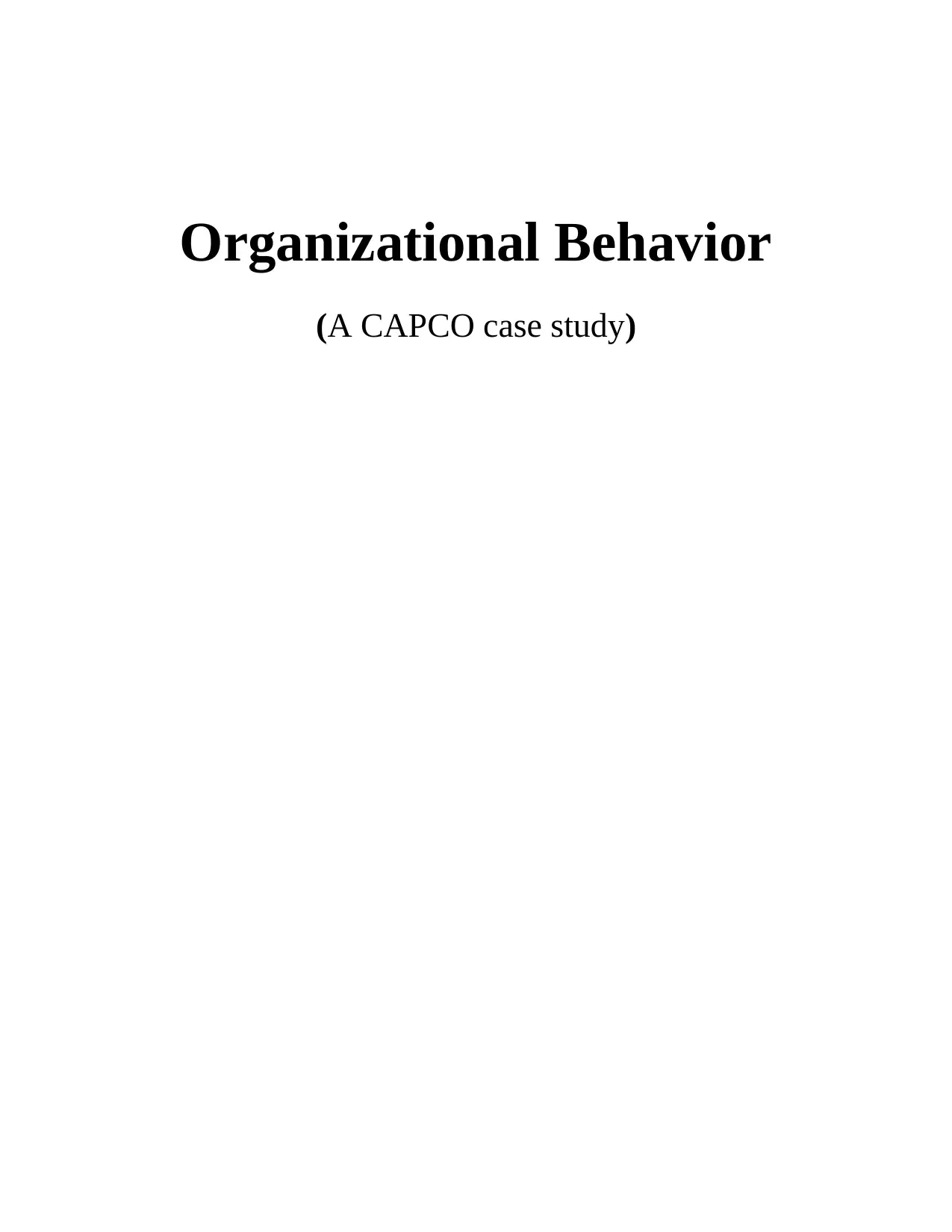
Organizational Behavior
(A CAPCO case study)
(A CAPCO case study)
Secure Best Marks with AI Grader
Need help grading? Try our AI Grader for instant feedback on your assignments.
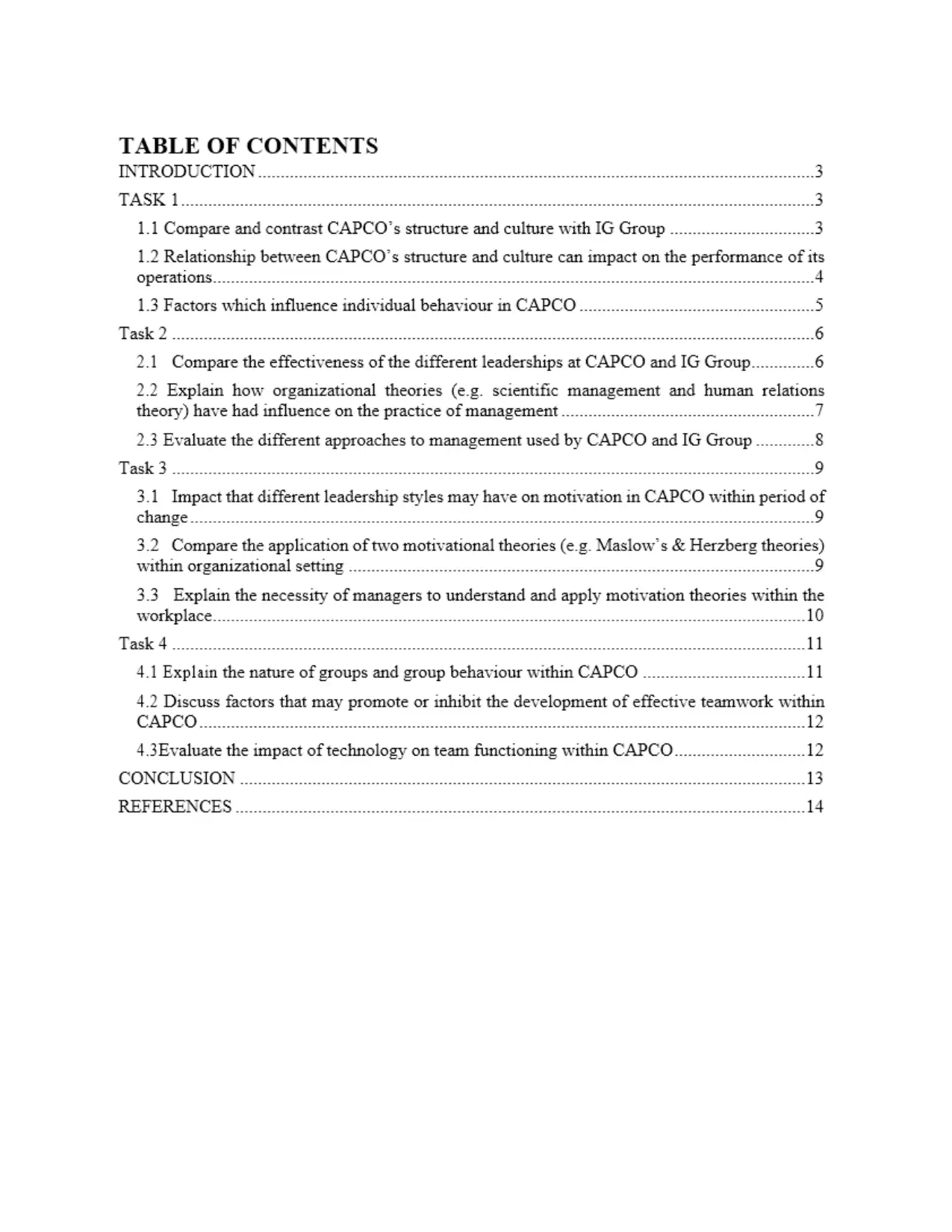
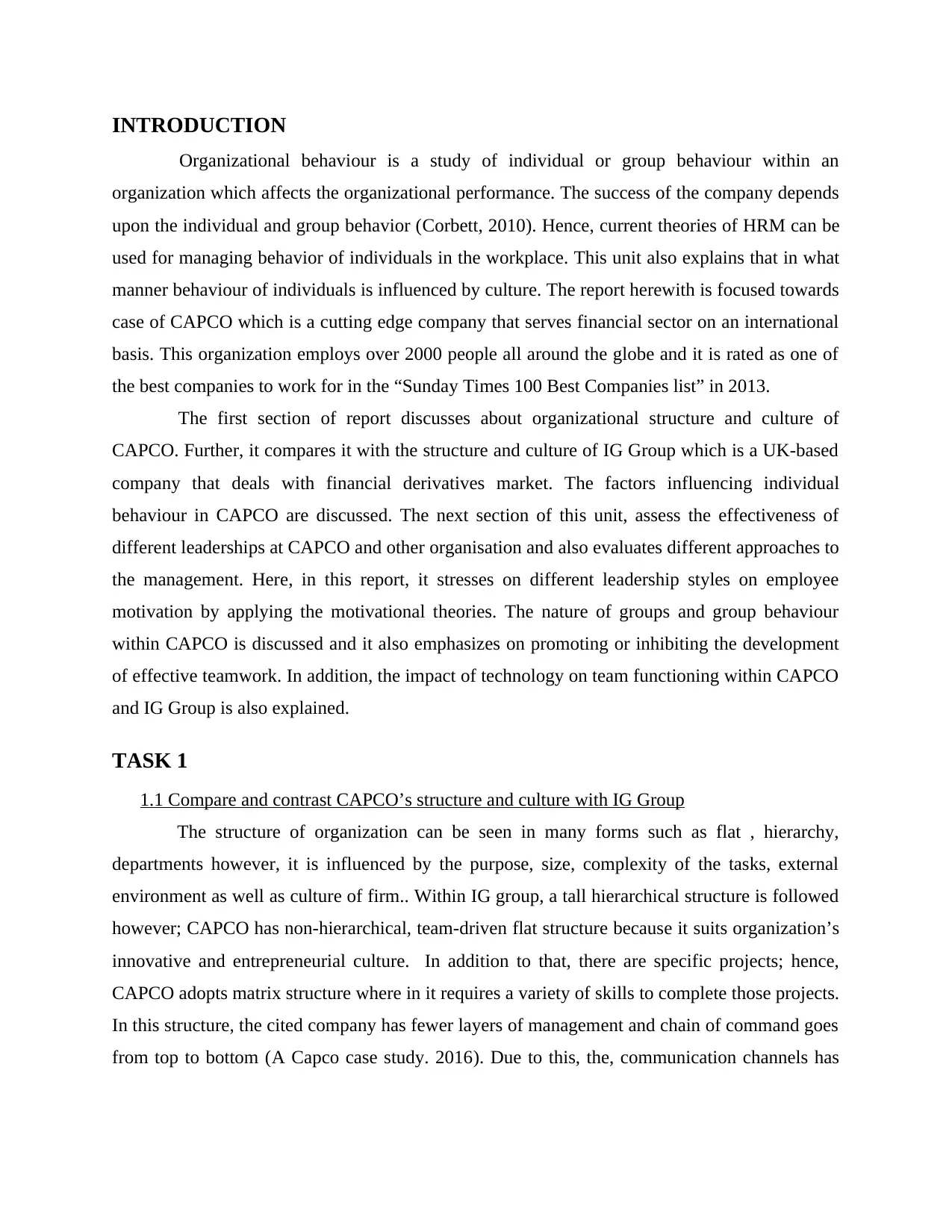
INTRODUCTION
Organizational behaviour is a study of individual or group behaviour within an
organization which affects the organizational performance. The success of the company depends
upon the individual and group behavior (Corbett, 2010). Hence, current theories of HRM can be
used for managing behavior of individuals in the workplace. This unit also explains that in what
manner behaviour of individuals is influenced by culture. The report herewith is focused towards
case of CAPCO which is a cutting edge company that serves financial sector on an international
basis. This organization employs over 2000 people all around the globe and it is rated as one of
the best companies to work for in the “Sunday Times 100 Best Companies list” in 2013.
The first section of report discusses about organizational structure and culture of
CAPCO. Further, it compares it with the structure and culture of IG Group which is a UK-based
company that deals with financial derivatives market. The factors influencing individual
behaviour in CAPCO are discussed. The next section of this unit, assess the effectiveness of
different leaderships at CAPCO and other organisation and also evaluates different approaches to
the management. Here, in this report, it stresses on different leadership styles on employee
motivation by applying the motivational theories. The nature of groups and group behaviour
within CAPCO is discussed and it also emphasizes on promoting or inhibiting the development
of effective teamwork. In addition, the impact of technology on team functioning within CAPCO
and IG Group is also explained.
TASK 1
1.1 Compare and contrast CAPCO’s structure and culture with IG Group
The structure of organization can be seen in many forms such as flat , hierarchy,
departments however, it is influenced by the purpose, size, complexity of the tasks, external
environment as well as culture of firm.. Within IG group, a tall hierarchical structure is followed
however; CAPCO has non-hierarchical, team-driven flat structure because it suits organization’s
innovative and entrepreneurial culture. In addition to that, there are specific projects; hence,
CAPCO adopts matrix structure where in it requires a variety of skills to complete those projects.
In this structure, the cited company has fewer layers of management and chain of command goes
from top to bottom (A Capco case study. 2016). Due to this, the, communication channels has
Organizational behaviour is a study of individual or group behaviour within an
organization which affects the organizational performance. The success of the company depends
upon the individual and group behavior (Corbett, 2010). Hence, current theories of HRM can be
used for managing behavior of individuals in the workplace. This unit also explains that in what
manner behaviour of individuals is influenced by culture. The report herewith is focused towards
case of CAPCO which is a cutting edge company that serves financial sector on an international
basis. This organization employs over 2000 people all around the globe and it is rated as one of
the best companies to work for in the “Sunday Times 100 Best Companies list” in 2013.
The first section of report discusses about organizational structure and culture of
CAPCO. Further, it compares it with the structure and culture of IG Group which is a UK-based
company that deals with financial derivatives market. The factors influencing individual
behaviour in CAPCO are discussed. The next section of this unit, assess the effectiveness of
different leaderships at CAPCO and other organisation and also evaluates different approaches to
the management. Here, in this report, it stresses on different leadership styles on employee
motivation by applying the motivational theories. The nature of groups and group behaviour
within CAPCO is discussed and it also emphasizes on promoting or inhibiting the development
of effective teamwork. In addition, the impact of technology on team functioning within CAPCO
and IG Group is also explained.
TASK 1
1.1 Compare and contrast CAPCO’s structure and culture with IG Group
The structure of organization can be seen in many forms such as flat , hierarchy,
departments however, it is influenced by the purpose, size, complexity of the tasks, external
environment as well as culture of firm.. Within IG group, a tall hierarchical structure is followed
however; CAPCO has non-hierarchical, team-driven flat structure because it suits organization’s
innovative and entrepreneurial culture. In addition to that, there are specific projects; hence,
CAPCO adopts matrix structure where in it requires a variety of skills to complete those projects.
In this structure, the cited company has fewer layers of management and chain of command goes
from top to bottom (A Capco case study. 2016). Due to this, the, communication channels has
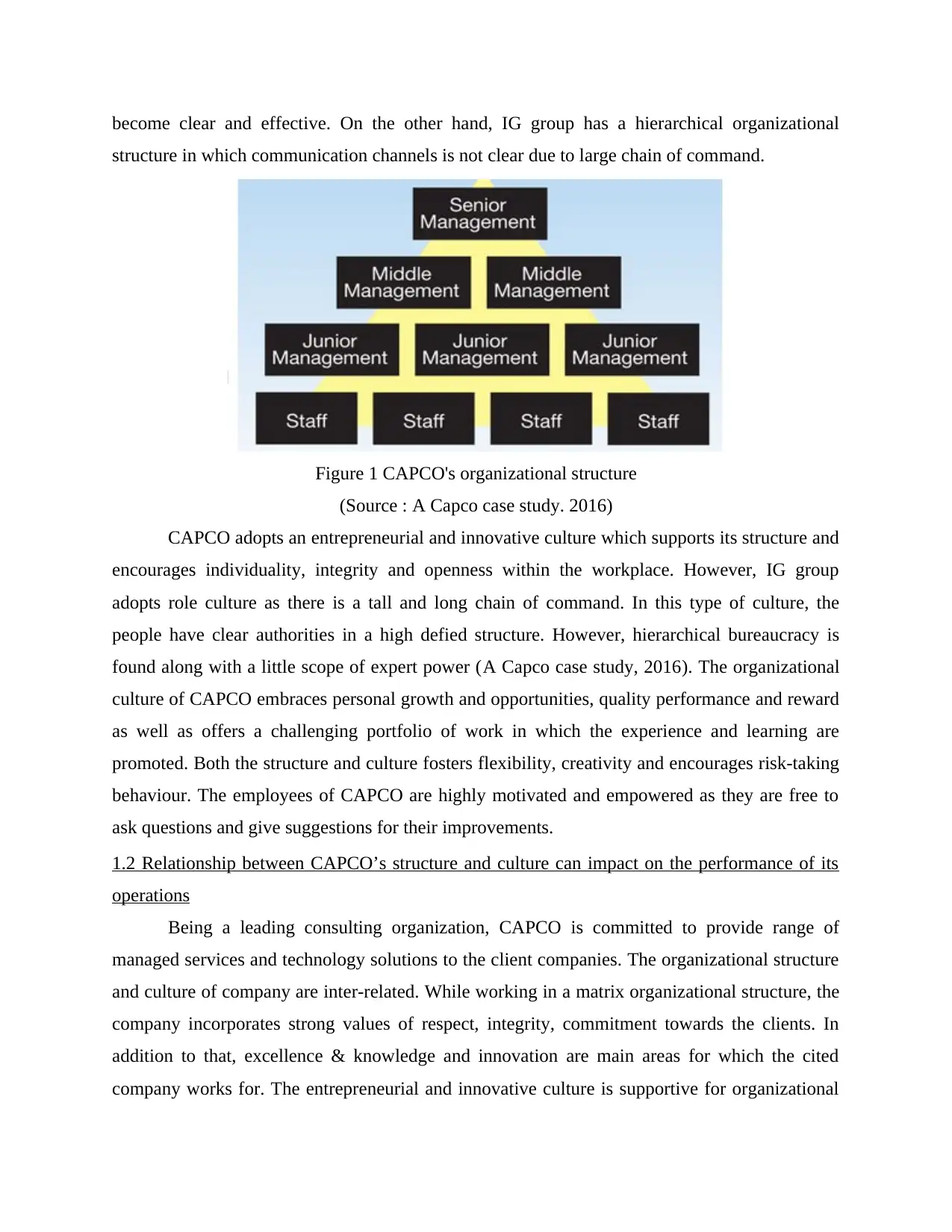
become clear and effective. On the other hand, IG group has a hierarchical organizational
structure in which communication channels is not clear due to large chain of command.
Figure 1 CAPCO's organizational structure
(Source : A Capco case study. 2016)
CAPCO adopts an entrepreneurial and innovative culture which supports its structure and
encourages individuality, integrity and openness within the workplace. However, IG group
adopts role culture as there is a tall and long chain of command. In this type of culture, the
people have clear authorities in a high defied structure. However, hierarchical bureaucracy is
found along with a little scope of expert power (A Capco case study, 2016). The organizational
culture of CAPCO embraces personal growth and opportunities, quality performance and reward
as well as offers a challenging portfolio of work in which the experience and learning are
promoted. Both the structure and culture fosters flexibility, creativity and encourages risk-taking
behaviour. The employees of CAPCO are highly motivated and empowered as they are free to
ask questions and give suggestions for their improvements.
1.2 Relationship between CAPCO’s structure and culture can impact on the performance of its
operations
Being a leading consulting organization, CAPCO is committed to provide range of
managed services and technology solutions to the client companies. The organizational structure
and culture of company are inter-related. While working in a matrix organizational structure, the
company incorporates strong values of respect, integrity, commitment towards the clients. In
addition to that, excellence & knowledge and innovation are main areas for which the cited
company works for. The entrepreneurial and innovative culture is supportive for organizational
structure in which communication channels is not clear due to large chain of command.
Figure 1 CAPCO's organizational structure
(Source : A Capco case study. 2016)
CAPCO adopts an entrepreneurial and innovative culture which supports its structure and
encourages individuality, integrity and openness within the workplace. However, IG group
adopts role culture as there is a tall and long chain of command. In this type of culture, the
people have clear authorities in a high defied structure. However, hierarchical bureaucracy is
found along with a little scope of expert power (A Capco case study, 2016). The organizational
culture of CAPCO embraces personal growth and opportunities, quality performance and reward
as well as offers a challenging portfolio of work in which the experience and learning are
promoted. Both the structure and culture fosters flexibility, creativity and encourages risk-taking
behaviour. The employees of CAPCO are highly motivated and empowered as they are free to
ask questions and give suggestions for their improvements.
1.2 Relationship between CAPCO’s structure and culture can impact on the performance of its
operations
Being a leading consulting organization, CAPCO is committed to provide range of
managed services and technology solutions to the client companies. The organizational structure
and culture of company are inter-related. While working in a matrix organizational structure, the
company incorporates strong values of respect, integrity, commitment towards the clients. In
addition to that, excellence & knowledge and innovation are main areas for which the cited
company works for. The entrepreneurial and innovative culture is supportive for organizational
Secure Best Marks with AI Grader
Need help grading? Try our AI Grader for instant feedback on your assignments.
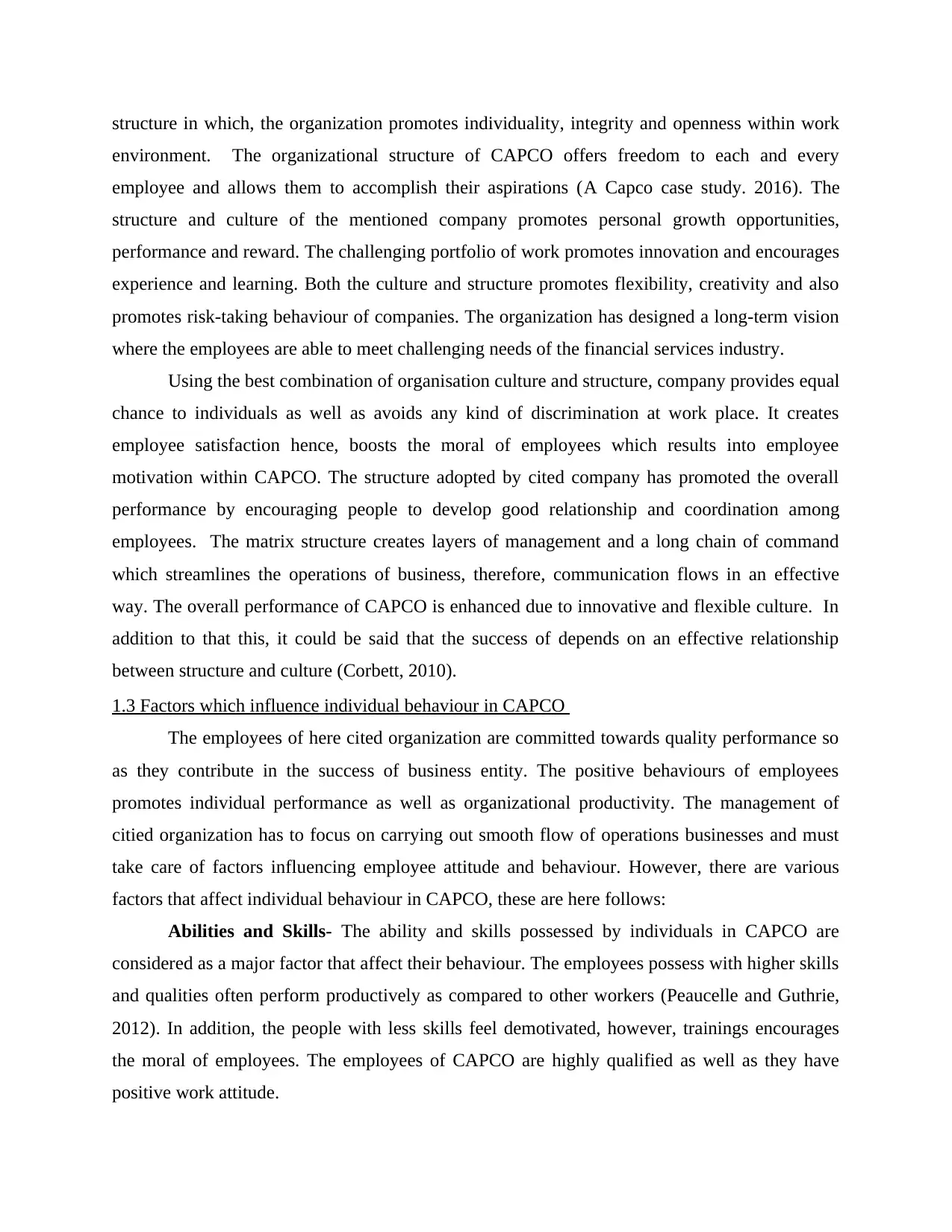
structure in which, the organization promotes individuality, integrity and openness within work
environment. The organizational structure of CAPCO offers freedom to each and every
employee and allows them to accomplish their aspirations (A Capco case study. 2016). The
structure and culture of the mentioned company promotes personal growth opportunities,
performance and reward. The challenging portfolio of work promotes innovation and encourages
experience and learning. Both the culture and structure promotes flexibility, creativity and also
promotes risk-taking behaviour of companies. The organization has designed a long-term vision
where the employees are able to meet challenging needs of the financial services industry.
Using the best combination of organisation culture and structure, company provides equal
chance to individuals as well as avoids any kind of discrimination at work place. It creates
employee satisfaction hence, boosts the moral of employees which results into employee
motivation within CAPCO. The structure adopted by cited company has promoted the overall
performance by encouraging people to develop good relationship and coordination among
employees. The matrix structure creates layers of management and a long chain of command
which streamlines the operations of business, therefore, communication flows in an effective
way. The overall performance of CAPCO is enhanced due to innovative and flexible culture. In
addition to that this, it could be said that the success of depends on an effective relationship
between structure and culture (Corbett, 2010).
1.3 Factors which influence individual behaviour in CAPCO
The employees of here cited organization are committed towards quality performance so
as they contribute in the success of business entity. The positive behaviours of employees
promotes individual performance as well as organizational productivity. The management of
citied organization has to focus on carrying out smooth flow of operations businesses and must
take care of factors influencing employee attitude and behaviour. However, there are various
factors that affect individual behaviour in CAPCO, these are here follows:
Abilities and Skills- The ability and skills possessed by individuals in CAPCO are
considered as a major factor that affect their behaviour. The employees possess with higher skills
and qualities often perform productively as compared to other workers (Peaucelle and Guthrie,
2012). In addition, the people with less skills feel demotivated, however, trainings encourages
the moral of employees. The employees of CAPCO are highly qualified as well as they have
positive work attitude.
environment. The organizational structure of CAPCO offers freedom to each and every
employee and allows them to accomplish their aspirations (A Capco case study. 2016). The
structure and culture of the mentioned company promotes personal growth opportunities,
performance and reward. The challenging portfolio of work promotes innovation and encourages
experience and learning. Both the culture and structure promotes flexibility, creativity and also
promotes risk-taking behaviour of companies. The organization has designed a long-term vision
where the employees are able to meet challenging needs of the financial services industry.
Using the best combination of organisation culture and structure, company provides equal
chance to individuals as well as avoids any kind of discrimination at work place. It creates
employee satisfaction hence, boosts the moral of employees which results into employee
motivation within CAPCO. The structure adopted by cited company has promoted the overall
performance by encouraging people to develop good relationship and coordination among
employees. The matrix structure creates layers of management and a long chain of command
which streamlines the operations of business, therefore, communication flows in an effective
way. The overall performance of CAPCO is enhanced due to innovative and flexible culture. In
addition to that this, it could be said that the success of depends on an effective relationship
between structure and culture (Corbett, 2010).
1.3 Factors which influence individual behaviour in CAPCO
The employees of here cited organization are committed towards quality performance so
as they contribute in the success of business entity. The positive behaviours of employees
promotes individual performance as well as organizational productivity. The management of
citied organization has to focus on carrying out smooth flow of operations businesses and must
take care of factors influencing employee attitude and behaviour. However, there are various
factors that affect individual behaviour in CAPCO, these are here follows:
Abilities and Skills- The ability and skills possessed by individuals in CAPCO are
considered as a major factor that affect their behaviour. The employees possess with higher skills
and qualities often perform productively as compared to other workers (Peaucelle and Guthrie,
2012). In addition, the people with less skills feel demotivated, however, trainings encourages
the moral of employees. The employees of CAPCO are highly qualified as well as they have
positive work attitude.
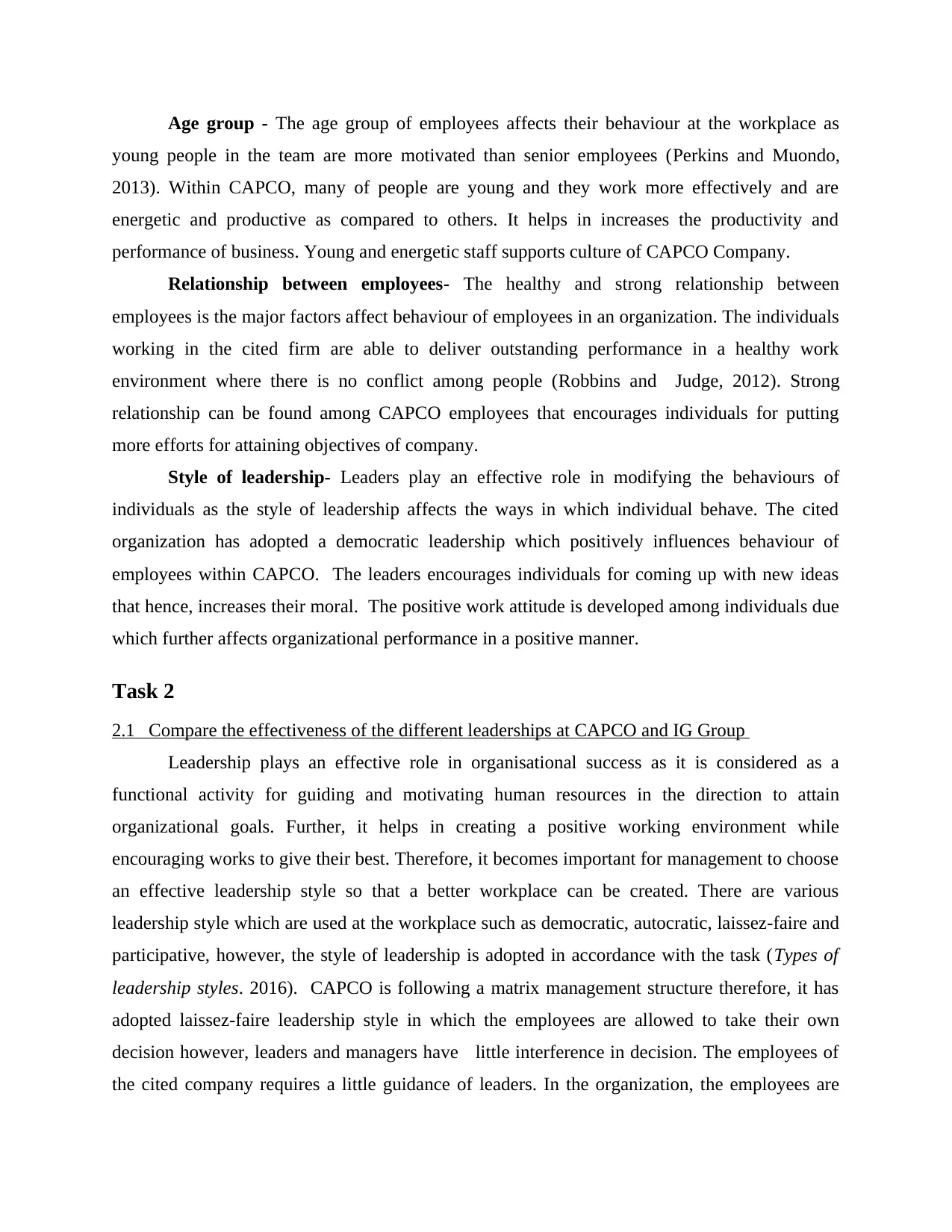
Age group - The age group of employees affects their behaviour at the workplace as
young people in the team are more motivated than senior employees (Perkins and Muondo,
2013). Within CAPCO, many of people are young and they work more effectively and are
energetic and productive as compared to others. It helps in increases the productivity and
performance of business. Young and energetic staff supports culture of CAPCO Company.
Relationship between employees- The healthy and strong relationship between
employees is the major factors affect behaviour of employees in an organization. The individuals
working in the cited firm are able to deliver outstanding performance in a healthy work
environment where there is no conflict among people (Robbins and Judge, 2012). Strong
relationship can be found among CAPCO employees that encourages individuals for putting
more efforts for attaining objectives of company.
Style of leadership- Leaders play an effective role in modifying the behaviours of
individuals as the style of leadership affects the ways in which individual behave. The cited
organization has adopted a democratic leadership which positively influences behaviour of
employees within CAPCO. The leaders encourages individuals for coming up with new ideas
that hence, increases their moral. The positive work attitude is developed among individuals due
which further affects organizational performance in a positive manner.
Task 2
2.1 Compare the effectiveness of the different leaderships at CAPCO and IG Group
Leadership plays an effective role in organisational success as it is considered as a
functional activity for guiding and motivating human resources in the direction to attain
organizational goals. Further, it helps in creating a positive working environment while
encouraging works to give their best. Therefore, it becomes important for management to choose
an effective leadership style so that a better workplace can be created. There are various
leadership style which are used at the workplace such as democratic, autocratic, laissez-faire and
participative, however, the style of leadership is adopted in accordance with the task (Types of
leadership styles. 2016). CAPCO is following a matrix management structure therefore, it has
adopted laissez-faire leadership style in which the employees are allowed to take their own
decision however, leaders and managers have little interference in decision. The employees of
the cited company requires a little guidance of leaders. In the organization, the employees are
young people in the team are more motivated than senior employees (Perkins and Muondo,
2013). Within CAPCO, many of people are young and they work more effectively and are
energetic and productive as compared to others. It helps in increases the productivity and
performance of business. Young and energetic staff supports culture of CAPCO Company.
Relationship between employees- The healthy and strong relationship between
employees is the major factors affect behaviour of employees in an organization. The individuals
working in the cited firm are able to deliver outstanding performance in a healthy work
environment where there is no conflict among people (Robbins and Judge, 2012). Strong
relationship can be found among CAPCO employees that encourages individuals for putting
more efforts for attaining objectives of company.
Style of leadership- Leaders play an effective role in modifying the behaviours of
individuals as the style of leadership affects the ways in which individual behave. The cited
organization has adopted a democratic leadership which positively influences behaviour of
employees within CAPCO. The leaders encourages individuals for coming up with new ideas
that hence, increases their moral. The positive work attitude is developed among individuals due
which further affects organizational performance in a positive manner.
Task 2
2.1 Compare the effectiveness of the different leaderships at CAPCO and IG Group
Leadership plays an effective role in organisational success as it is considered as a
functional activity for guiding and motivating human resources in the direction to attain
organizational goals. Further, it helps in creating a positive working environment while
encouraging works to give their best. Therefore, it becomes important for management to choose
an effective leadership style so that a better workplace can be created. There are various
leadership style which are used at the workplace such as democratic, autocratic, laissez-faire and
participative, however, the style of leadership is adopted in accordance with the task (Types of
leadership styles. 2016). CAPCO is following a matrix management structure therefore, it has
adopted laissez-faire leadership style in which the employees are allowed to take their own
decision however, leaders and managers have little interference in decision. The employees of
the cited company requires a little guidance of leaders. In the organization, the employees are
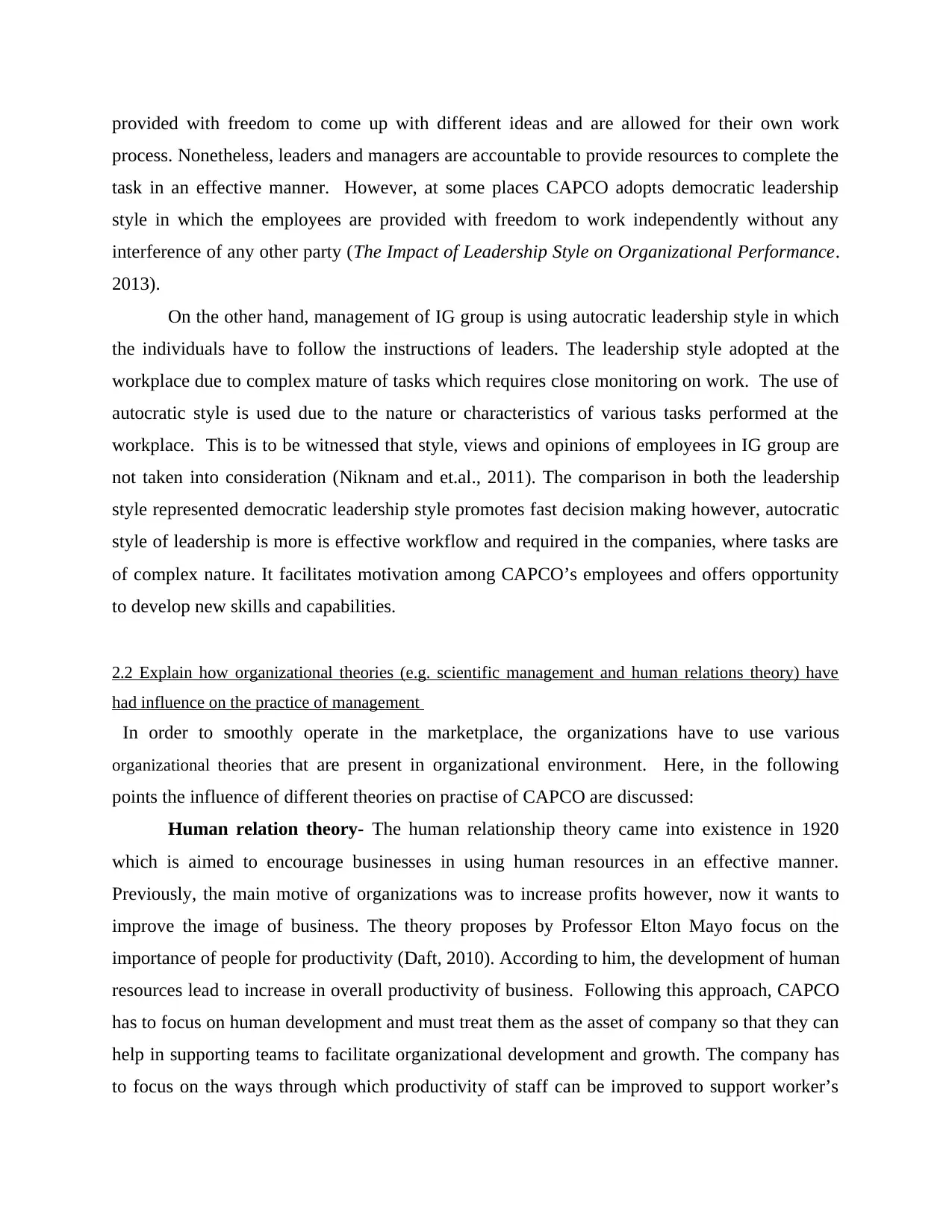
provided with freedom to come up with different ideas and are allowed for their own work
process. Nonetheless, leaders and managers are accountable to provide resources to complete the
task in an effective manner. However, at some places CAPCO adopts democratic leadership
style in which the employees are provided with freedom to work independently without any
interference of any other party (The Impact of Leadership Style on Organizational Performance.
2013).
On the other hand, management of IG group is using autocratic leadership style in which
the individuals have to follow the instructions of leaders. The leadership style adopted at the
workplace due to complex mature of tasks which requires close monitoring on work. The use of
autocratic style is used due to the nature or characteristics of various tasks performed at the
workplace. This is to be witnessed that style, views and opinions of employees in IG group are
not taken into consideration (Niknam and et.al., 2011). The comparison in both the leadership
style represented democratic leadership style promotes fast decision making however, autocratic
style of leadership is more is effective workflow and required in the companies, where tasks are
of complex nature. It facilitates motivation among CAPCO’s employees and offers opportunity
to develop new skills and capabilities.
2.2 Explain how organizational theories (e.g. scientific management and human relations theory) have
had influence on the practice of management
In order to smoothly operate in the marketplace, the organizations have to use various
organizational theories that are present in organizational environment. Here, in the following
points the influence of different theories on practise of CAPCO are discussed:
Human relation theory- The human relationship theory came into existence in 1920
which is aimed to encourage businesses in using human resources in an effective manner.
Previously, the main motive of organizations was to increase profits however, now it wants to
improve the image of business. The theory proposes by Professor Elton Mayo focus on the
importance of people for productivity (Daft, 2010). According to him, the development of human
resources lead to increase in overall productivity of business. Following this approach, CAPCO
has to focus on human development and must treat them as the asset of company so that they can
help in supporting teams to facilitate organizational development and growth. The company has
to focus on the ways through which productivity of staff can be improved to support worker’s
process. Nonetheless, leaders and managers are accountable to provide resources to complete the
task in an effective manner. However, at some places CAPCO adopts democratic leadership
style in which the employees are provided with freedom to work independently without any
interference of any other party (The Impact of Leadership Style on Organizational Performance.
2013).
On the other hand, management of IG group is using autocratic leadership style in which
the individuals have to follow the instructions of leaders. The leadership style adopted at the
workplace due to complex mature of tasks which requires close monitoring on work. The use of
autocratic style is used due to the nature or characteristics of various tasks performed at the
workplace. This is to be witnessed that style, views and opinions of employees in IG group are
not taken into consideration (Niknam and et.al., 2011). The comparison in both the leadership
style represented democratic leadership style promotes fast decision making however, autocratic
style of leadership is more is effective workflow and required in the companies, where tasks are
of complex nature. It facilitates motivation among CAPCO’s employees and offers opportunity
to develop new skills and capabilities.
2.2 Explain how organizational theories (e.g. scientific management and human relations theory) have
had influence on the practice of management
In order to smoothly operate in the marketplace, the organizations have to use various
organizational theories that are present in organizational environment. Here, in the following
points the influence of different theories on practise of CAPCO are discussed:
Human relation theory- The human relationship theory came into existence in 1920
which is aimed to encourage businesses in using human resources in an effective manner.
Previously, the main motive of organizations was to increase profits however, now it wants to
improve the image of business. The theory proposes by Professor Elton Mayo focus on the
importance of people for productivity (Daft, 2010). According to him, the development of human
resources lead to increase in overall productivity of business. Following this approach, CAPCO
has to focus on human development and must treat them as the asset of company so that they can
help in supporting teams to facilitate organizational development and growth. The company has
to focus on the ways through which productivity of staff can be improved to support worker’s
Paraphrase This Document
Need a fresh take? Get an instant paraphrase of this document with our AI Paraphraser
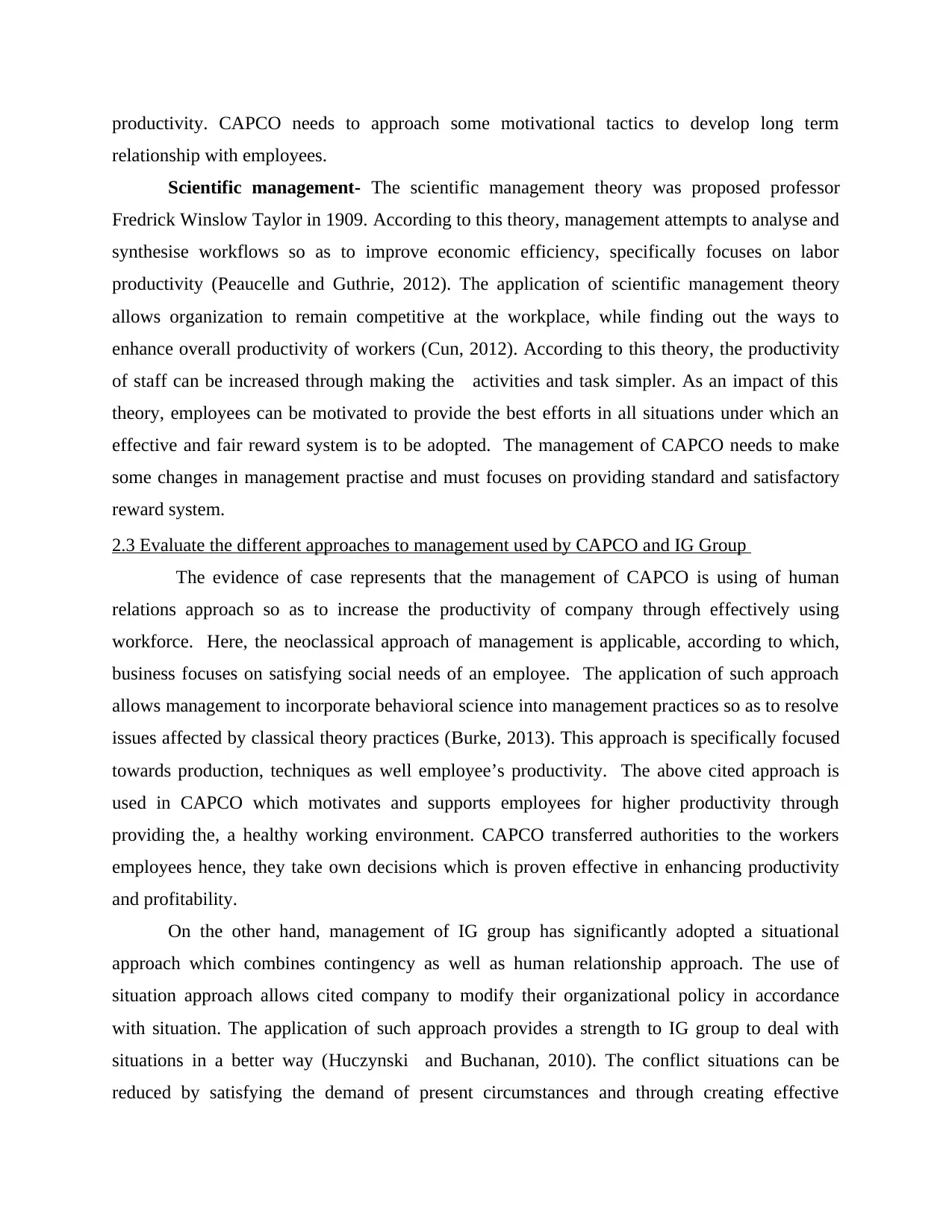
productivity. CAPCO needs to approach some motivational tactics to develop long term
relationship with employees.
Scientific management- The scientific management theory was proposed professor
Fredrick Winslow Taylor in 1909. According to this theory, management attempts to analyse and
synthesise workflows so as to improve economic efficiency, specifically focuses on labor
productivity (Peaucelle and Guthrie, 2012). The application of scientific management theory
allows organization to remain competitive at the workplace, while finding out the ways to
enhance overall productivity of workers (Cun, 2012). According to this theory, the productivity
of staff can be increased through making the activities and task simpler. As an impact of this
theory, employees can be motivated to provide the best efforts in all situations under which an
effective and fair reward system is to be adopted. The management of CAPCO needs to make
some changes in management practise and must focuses on providing standard and satisfactory
reward system.
2.3 Evaluate the different approaches to management used by CAPCO and IG Group
The evidence of case represents that the management of CAPCO is using of human
relations approach so as to increase the productivity of company through effectively using
workforce. Here, the neoclassical approach of management is applicable, according to which,
business focuses on satisfying social needs of an employee. The application of such approach
allows management to incorporate behavioral science into management practices so as to resolve
issues affected by classical theory practices (Burke, 2013). This approach is specifically focused
towards production, techniques as well employee’s productivity. The above cited approach is
used in CAPCO which motivates and supports employees for higher productivity through
providing the, a healthy working environment. CAPCO transferred authorities to the workers
employees hence, they take own decisions which is proven effective in enhancing productivity
and profitability.
On the other hand, management of IG group has significantly adopted a situational
approach which combines contingency as well as human relationship approach. The use of
situation approach allows cited company to modify their organizational policy in accordance
with situation. The application of such approach provides a strength to IG group to deal with
situations in a better way (Huczynski and Buchanan, 2010). The conflict situations can be
reduced by satisfying the demand of present circumstances and through creating effective
relationship with employees.
Scientific management- The scientific management theory was proposed professor
Fredrick Winslow Taylor in 1909. According to this theory, management attempts to analyse and
synthesise workflows so as to improve economic efficiency, specifically focuses on labor
productivity (Peaucelle and Guthrie, 2012). The application of scientific management theory
allows organization to remain competitive at the workplace, while finding out the ways to
enhance overall productivity of workers (Cun, 2012). According to this theory, the productivity
of staff can be increased through making the activities and task simpler. As an impact of this
theory, employees can be motivated to provide the best efforts in all situations under which an
effective and fair reward system is to be adopted. The management of CAPCO needs to make
some changes in management practise and must focuses on providing standard and satisfactory
reward system.
2.3 Evaluate the different approaches to management used by CAPCO and IG Group
The evidence of case represents that the management of CAPCO is using of human
relations approach so as to increase the productivity of company through effectively using
workforce. Here, the neoclassical approach of management is applicable, according to which,
business focuses on satisfying social needs of an employee. The application of such approach
allows management to incorporate behavioral science into management practices so as to resolve
issues affected by classical theory practices (Burke, 2013). This approach is specifically focused
towards production, techniques as well employee’s productivity. The above cited approach is
used in CAPCO which motivates and supports employees for higher productivity through
providing the, a healthy working environment. CAPCO transferred authorities to the workers
employees hence, they take own decisions which is proven effective in enhancing productivity
and profitability.
On the other hand, management of IG group has significantly adopted a situational
approach which combines contingency as well as human relationship approach. The use of
situation approach allows cited company to modify their organizational policy in accordance
with situation. The application of such approach provides a strength to IG group to deal with
situations in a better way (Huczynski and Buchanan, 2010). The conflict situations can be
reduced by satisfying the demand of present circumstances and through creating effective
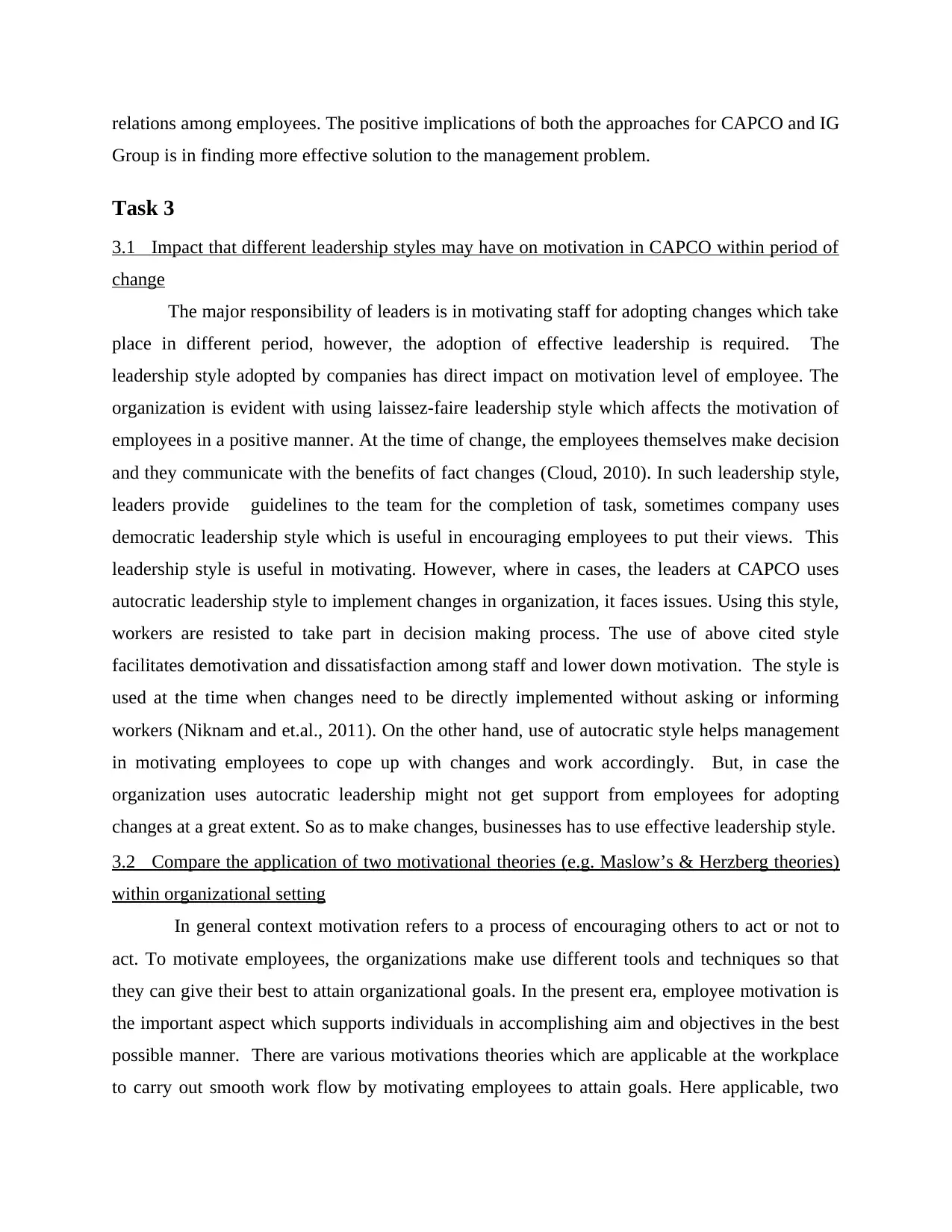
relations among employees. The positive implications of both the approaches for CAPCO and IG
Group is in finding more effective solution to the management problem.
Task 3
3.1 Impact that different leadership styles may have on motivation in CAPCO within period of
change
The major responsibility of leaders is in motivating staff for adopting changes which take
place in different period, however, the adoption of effective leadership is required. The
leadership style adopted by companies has direct impact on motivation level of employee. The
organization is evident with using laissez-faire leadership style which affects the motivation of
employees in a positive manner. At the time of change, the employees themselves make decision
and they communicate with the benefits of fact changes (Cloud, 2010). In such leadership style,
leaders provide guidelines to the team for the completion of task, sometimes company uses
democratic leadership style which is useful in encouraging employees to put their views. This
leadership style is useful in motivating. However, where in cases, the leaders at CAPCO uses
autocratic leadership style to implement changes in organization, it faces issues. Using this style,
workers are resisted to take part in decision making process. The use of above cited style
facilitates demotivation and dissatisfaction among staff and lower down motivation. The style is
used at the time when changes need to be directly implemented without asking or informing
workers (Niknam and et.al., 2011). On the other hand, use of autocratic style helps management
in motivating employees to cope up with changes and work accordingly. But, in case the
organization uses autocratic leadership might not get support from employees for adopting
changes at a great extent. So as to make changes, businesses has to use effective leadership style.
3.2 Compare the application of two motivational theories (e.g. Maslow’s & Herzberg theories)
within organizational setting
In general context motivation refers to a process of encouraging others to act or not to
act. To motivate employees, the organizations make use different tools and techniques so that
they can give their best to attain organizational goals. In the present era, employee motivation is
the important aspect which supports individuals in accomplishing aim and objectives in the best
possible manner. There are various motivations theories which are applicable at the workplace
to carry out smooth work flow by motivating employees to attain goals. Here applicable, two
Group is in finding more effective solution to the management problem.
Task 3
3.1 Impact that different leadership styles may have on motivation in CAPCO within period of
change
The major responsibility of leaders is in motivating staff for adopting changes which take
place in different period, however, the adoption of effective leadership is required. The
leadership style adopted by companies has direct impact on motivation level of employee. The
organization is evident with using laissez-faire leadership style which affects the motivation of
employees in a positive manner. At the time of change, the employees themselves make decision
and they communicate with the benefits of fact changes (Cloud, 2010). In such leadership style,
leaders provide guidelines to the team for the completion of task, sometimes company uses
democratic leadership style which is useful in encouraging employees to put their views. This
leadership style is useful in motivating. However, where in cases, the leaders at CAPCO uses
autocratic leadership style to implement changes in organization, it faces issues. Using this style,
workers are resisted to take part in decision making process. The use of above cited style
facilitates demotivation and dissatisfaction among staff and lower down motivation. The style is
used at the time when changes need to be directly implemented without asking or informing
workers (Niknam and et.al., 2011). On the other hand, use of autocratic style helps management
in motivating employees to cope up with changes and work accordingly. But, in case the
organization uses autocratic leadership might not get support from employees for adopting
changes at a great extent. So as to make changes, businesses has to use effective leadership style.
3.2 Compare the application of two motivational theories (e.g. Maslow’s & Herzberg theories)
within organizational setting
In general context motivation refers to a process of encouraging others to act or not to
act. To motivate employees, the organizations make use different tools and techniques so that
they can give their best to attain organizational goals. In the present era, employee motivation is
the important aspect which supports individuals in accomplishing aim and objectives in the best
possible manner. There are various motivations theories which are applicable at the workplace
to carry out smooth work flow by motivating employees to attain goals. Here applicable, two
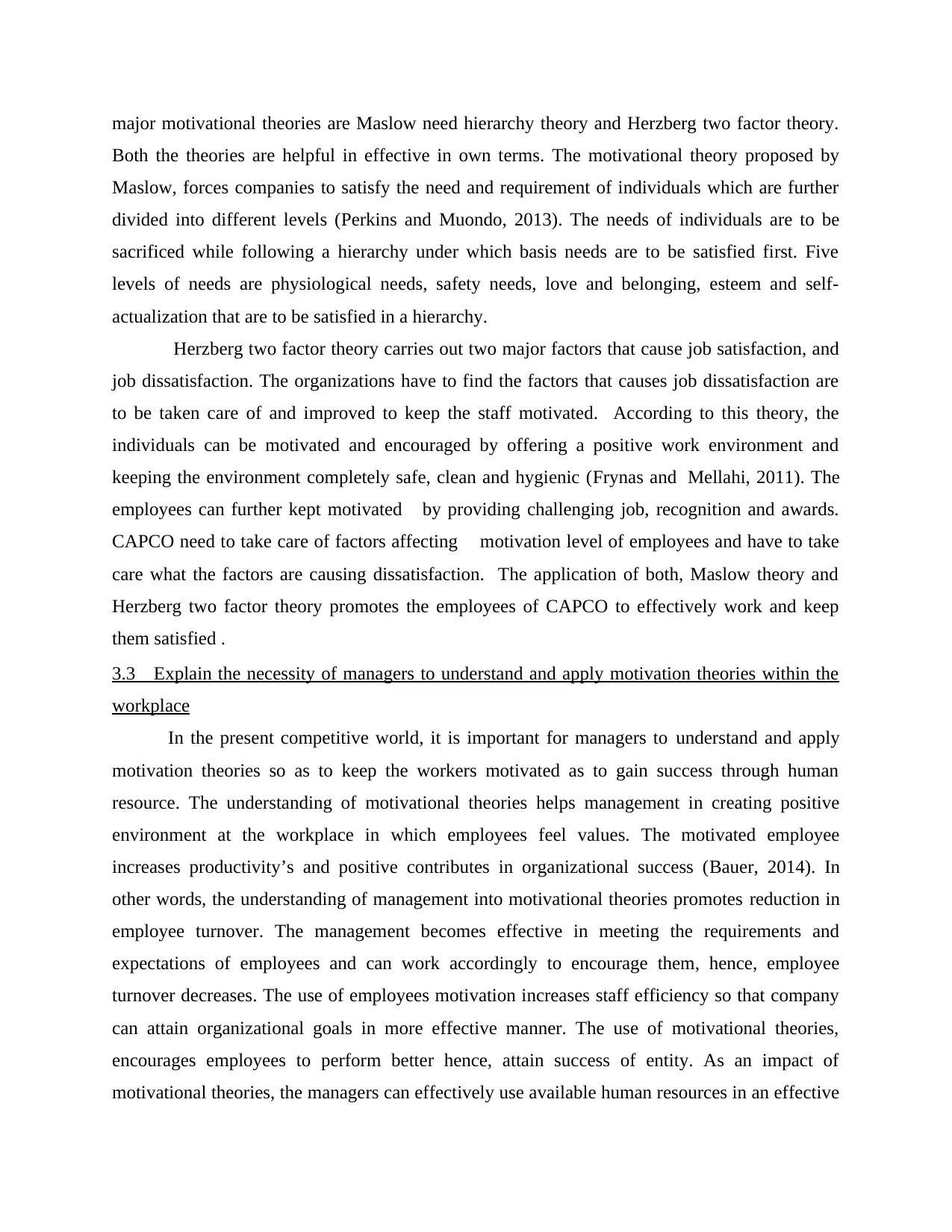
major motivational theories are Maslow need hierarchy theory and Herzberg two factor theory.
Both the theories are helpful in effective in own terms. The motivational theory proposed by
Maslow, forces companies to satisfy the need and requirement of individuals which are further
divided into different levels (Perkins and Muondo, 2013). The needs of individuals are to be
sacrificed while following a hierarchy under which basis needs are to be satisfied first. Five
levels of needs are physiological needs, safety needs, love and belonging, esteem and self-
actualization that are to be satisfied in a hierarchy.
Herzberg two factor theory carries out two major factors that cause job satisfaction, and
job dissatisfaction. The organizations have to find the factors that causes job dissatisfaction are
to be taken care of and improved to keep the staff motivated. According to this theory, the
individuals can be motivated and encouraged by offering a positive work environment and
keeping the environment completely safe, clean and hygienic (Frynas and Mellahi, 2011). The
employees can further kept motivated by providing challenging job, recognition and awards.
CAPCO need to take care of factors affecting motivation level of employees and have to take
care what the factors are causing dissatisfaction. The application of both, Maslow theory and
Herzberg two factor theory promotes the employees of CAPCO to effectively work and keep
them satisfied .
3.3 Explain the necessity of managers to understand and apply motivation theories within the
workplace
In the present competitive world, it is important for managers to understand and apply
motivation theories so as to keep the workers motivated as to gain success through human
resource. The understanding of motivational theories helps management in creating positive
environment at the workplace in which employees feel values. The motivated employee
increases productivity’s and positive contributes in organizational success (Bauer, 2014). In
other words, the understanding of management into motivational theories promotes reduction in
employee turnover. The management becomes effective in meeting the requirements and
expectations of employees and can work accordingly to encourage them, hence, employee
turnover decreases. The use of employees motivation increases staff efficiency so that company
can attain organizational goals in more effective manner. The use of motivational theories,
encourages employees to perform better hence, attain success of entity. As an impact of
motivational theories, the managers can effectively use available human resources in an effective
Both the theories are helpful in effective in own terms. The motivational theory proposed by
Maslow, forces companies to satisfy the need and requirement of individuals which are further
divided into different levels (Perkins and Muondo, 2013). The needs of individuals are to be
sacrificed while following a hierarchy under which basis needs are to be satisfied first. Five
levels of needs are physiological needs, safety needs, love and belonging, esteem and self-
actualization that are to be satisfied in a hierarchy.
Herzberg two factor theory carries out two major factors that cause job satisfaction, and
job dissatisfaction. The organizations have to find the factors that causes job dissatisfaction are
to be taken care of and improved to keep the staff motivated. According to this theory, the
individuals can be motivated and encouraged by offering a positive work environment and
keeping the environment completely safe, clean and hygienic (Frynas and Mellahi, 2011). The
employees can further kept motivated by providing challenging job, recognition and awards.
CAPCO need to take care of factors affecting motivation level of employees and have to take
care what the factors are causing dissatisfaction. The application of both, Maslow theory and
Herzberg two factor theory promotes the employees of CAPCO to effectively work and keep
them satisfied .
3.3 Explain the necessity of managers to understand and apply motivation theories within the
workplace
In the present competitive world, it is important for managers to understand and apply
motivation theories so as to keep the workers motivated as to gain success through human
resource. The understanding of motivational theories helps management in creating positive
environment at the workplace in which employees feel values. The motivated employee
increases productivity’s and positive contributes in organizational success (Bauer, 2014). In
other words, the understanding of management into motivational theories promotes reduction in
employee turnover. The management becomes effective in meeting the requirements and
expectations of employees and can work accordingly to encourage them, hence, employee
turnover decreases. The use of employees motivation increases staff efficiency so that company
can attain organizational goals in more effective manner. The use of motivational theories,
encourages employees to perform better hence, attain success of entity. As an impact of
motivational theories, the managers can effectively use available human resources in an effective
Secure Best Marks with AI Grader
Need help grading? Try our AI Grader for instant feedback on your assignments.
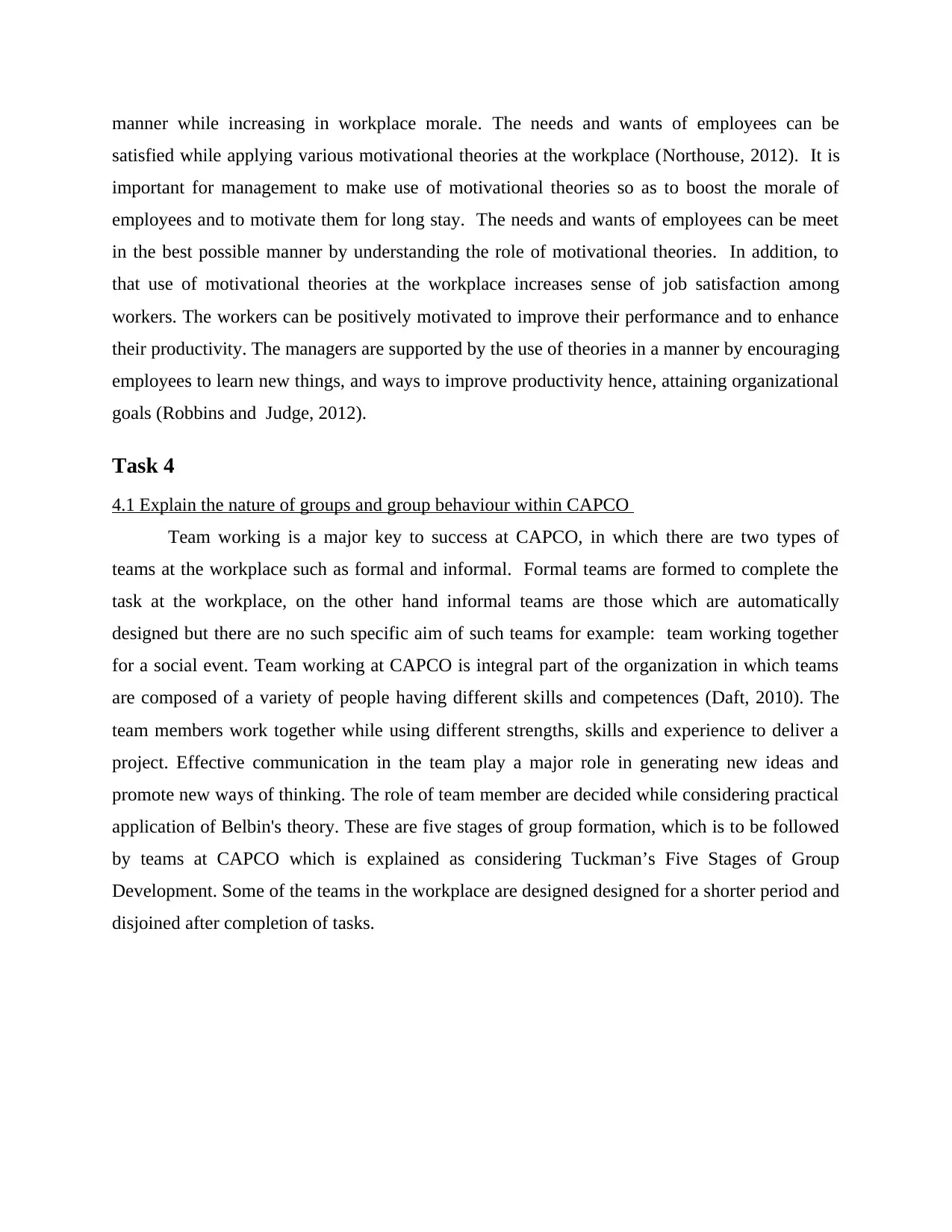
manner while increasing in workplace morale. The needs and wants of employees can be
satisfied while applying various motivational theories at the workplace (Northouse, 2012). It is
important for management to make use of motivational theories so as to boost the morale of
employees and to motivate them for long stay. The needs and wants of employees can be meet
in the best possible manner by understanding the role of motivational theories. In addition, to
that use of motivational theories at the workplace increases sense of job satisfaction among
workers. The workers can be positively motivated to improve their performance and to enhance
their productivity. The managers are supported by the use of theories in a manner by encouraging
employees to learn new things, and ways to improve productivity hence, attaining organizational
goals (Robbins and Judge, 2012).
Task 4
4.1 Explain the nature of groups and group behaviour within CAPCO
Team working is a major key to success at CAPCO, in which there are two types of
teams at the workplace such as formal and informal. Formal teams are formed to complete the
task at the workplace, on the other hand informal teams are those which are automatically
designed but there are no such specific aim of such teams for example: team working together
for a social event. Team working at CAPCO is integral part of the organization in which teams
are composed of a variety of people having different skills and competences (Daft, 2010). The
team members work together while using different strengths, skills and experience to deliver a
project. Effective communication in the team play a major role in generating new ideas and
promote new ways of thinking. The role of team member are decided while considering practical
application of Belbin's theory. These are five stages of group formation, which is to be followed
by teams at CAPCO which is explained as considering Tuckman’s Five Stages of Group
Development. Some of the teams in the workplace are designed designed for a shorter period and
disjoined after completion of tasks.
satisfied while applying various motivational theories at the workplace (Northouse, 2012). It is
important for management to make use of motivational theories so as to boost the morale of
employees and to motivate them for long stay. The needs and wants of employees can be meet
in the best possible manner by understanding the role of motivational theories. In addition, to
that use of motivational theories at the workplace increases sense of job satisfaction among
workers. The workers can be positively motivated to improve their performance and to enhance
their productivity. The managers are supported by the use of theories in a manner by encouraging
employees to learn new things, and ways to improve productivity hence, attaining organizational
goals (Robbins and Judge, 2012).
Task 4
4.1 Explain the nature of groups and group behaviour within CAPCO
Team working is a major key to success at CAPCO, in which there are two types of
teams at the workplace such as formal and informal. Formal teams are formed to complete the
task at the workplace, on the other hand informal teams are those which are automatically
designed but there are no such specific aim of such teams for example: team working together
for a social event. Team working at CAPCO is integral part of the organization in which teams
are composed of a variety of people having different skills and competences (Daft, 2010). The
team members work together while using different strengths, skills and experience to deliver a
project. Effective communication in the team play a major role in generating new ideas and
promote new ways of thinking. The role of team member are decided while considering practical
application of Belbin's theory. These are five stages of group formation, which is to be followed
by teams at CAPCO which is explained as considering Tuckman’s Five Stages of Group
Development. Some of the teams in the workplace are designed designed for a shorter period and
disjoined after completion of tasks.
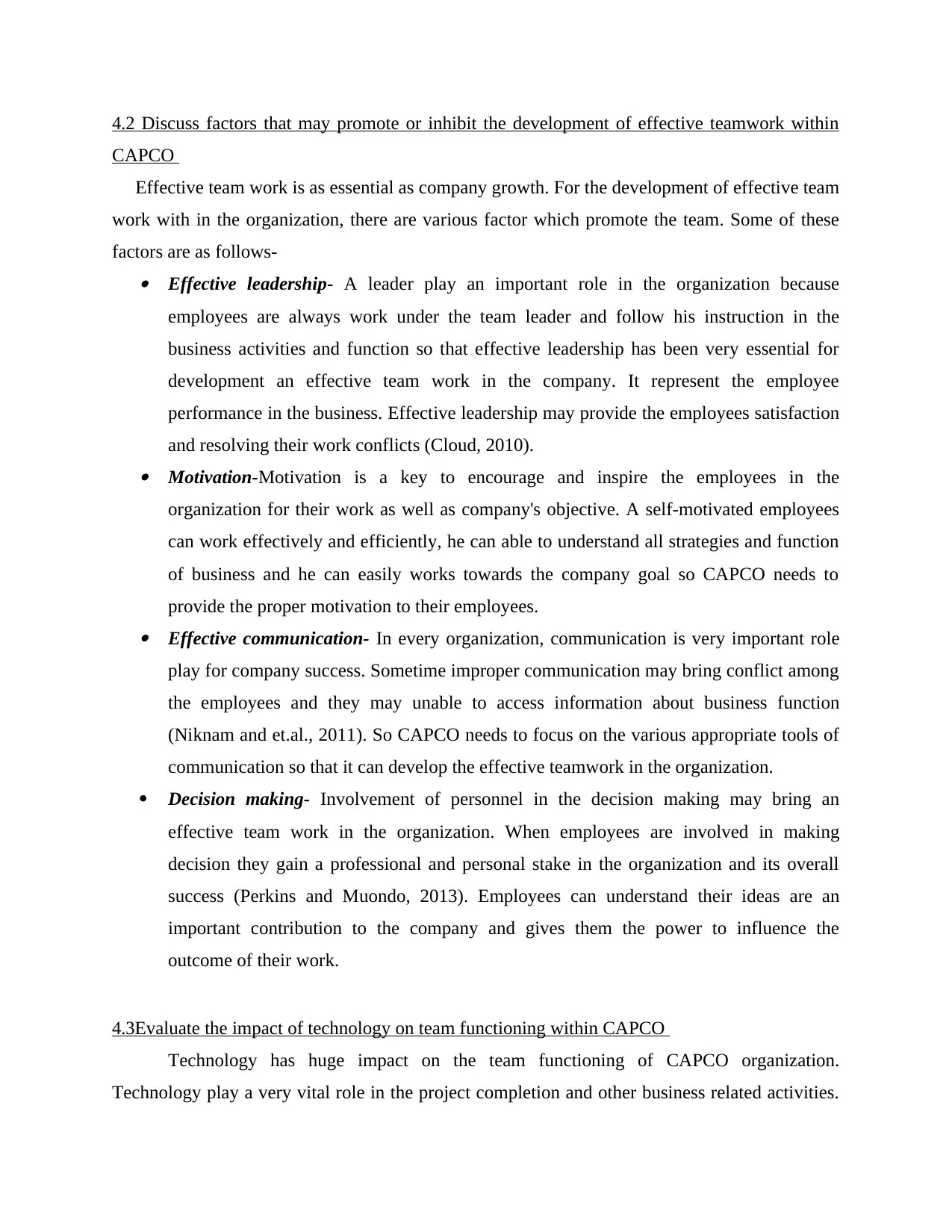
4.2 Discuss factors that may promote or inhibit the development of effective teamwork within
CAPCO
Effective team work is as essential as company growth. For the development of effective team
work with in the organization, there are various factor which promote the team. Some of these
factors are as follows- Effective leadership- A leader play an important role in the organization because
employees are always work under the team leader and follow his instruction in the
business activities and function so that effective leadership has been very essential for
development an effective team work in the company. It represent the employee
performance in the business. Effective leadership may provide the employees satisfaction
and resolving their work conflicts (Cloud, 2010). Motivation-Motivation is a key to encourage and inspire the employees in the
organization for their work as well as company's objective. A self-motivated employees
can work effectively and efficiently, he can able to understand all strategies and function
of business and he can easily works towards the company goal so CAPCO needs to
provide the proper motivation to their employees. Effective communication- In every organization, communication is very important role
play for company success. Sometime improper communication may bring conflict among
the employees and they may unable to access information about business function
(Niknam and et.al., 2011). So CAPCO needs to focus on the various appropriate tools of
communication so that it can develop the effective teamwork in the organization.
Decision making- Involvement of personnel in the decision making may bring an
effective team work in the organization. When employees are involved in making
decision they gain a professional and personal stake in the organization and its overall
success (Perkins and Muondo, 2013). Employees can understand their ideas are an
important contribution to the company and gives them the power to influence the
outcome of their work.
4.3Evaluate the impact of technology on team functioning within CAPCO
Technology has huge impact on the team functioning of CAPCO organization.
Technology play a very vital role in the project completion and other business related activities.
CAPCO
Effective team work is as essential as company growth. For the development of effective team
work with in the organization, there are various factor which promote the team. Some of these
factors are as follows- Effective leadership- A leader play an important role in the organization because
employees are always work under the team leader and follow his instruction in the
business activities and function so that effective leadership has been very essential for
development an effective team work in the company. It represent the employee
performance in the business. Effective leadership may provide the employees satisfaction
and resolving their work conflicts (Cloud, 2010). Motivation-Motivation is a key to encourage and inspire the employees in the
organization for their work as well as company's objective. A self-motivated employees
can work effectively and efficiently, he can able to understand all strategies and function
of business and he can easily works towards the company goal so CAPCO needs to
provide the proper motivation to their employees. Effective communication- In every organization, communication is very important role
play for company success. Sometime improper communication may bring conflict among
the employees and they may unable to access information about business function
(Niknam and et.al., 2011). So CAPCO needs to focus on the various appropriate tools of
communication so that it can develop the effective teamwork in the organization.
Decision making- Involvement of personnel in the decision making may bring an
effective team work in the organization. When employees are involved in making
decision they gain a professional and personal stake in the organization and its overall
success (Perkins and Muondo, 2013). Employees can understand their ideas are an
important contribution to the company and gives them the power to influence the
outcome of their work.
4.3Evaluate the impact of technology on team functioning within CAPCO
Technology has huge impact on the team functioning of CAPCO organization.
Technology play a very vital role in the project completion and other business related activities.
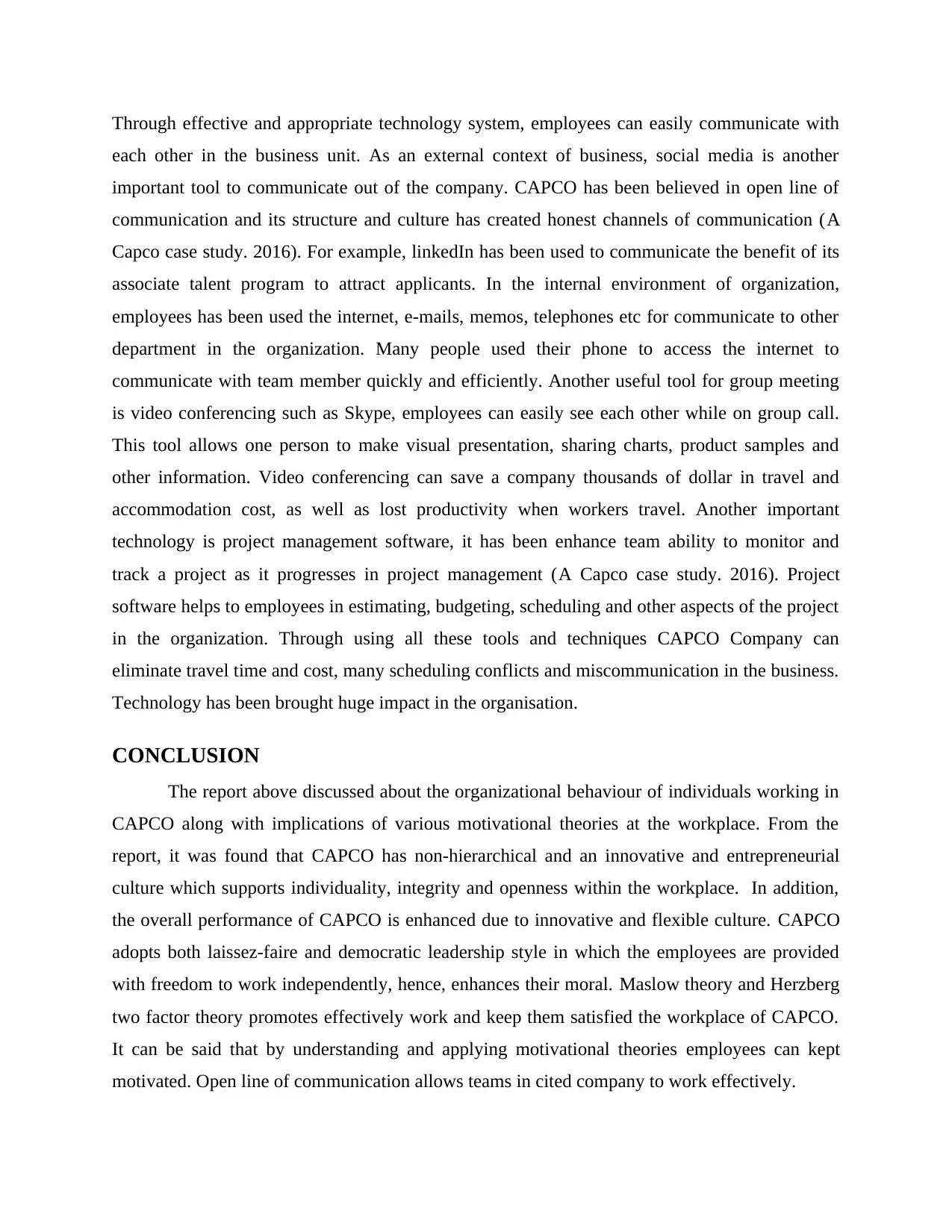
Through effective and appropriate technology system, employees can easily communicate with
each other in the business unit. As an external context of business, social media is another
important tool to communicate out of the company. CAPCO has been believed in open line of
communication and its structure and culture has created honest channels of communication (A
Capco case study. 2016). For example, linkedIn has been used to communicate the benefit of its
associate talent program to attract applicants. In the internal environment of organization,
employees has been used the internet, e-mails, memos, telephones etc for communicate to other
department in the organization. Many people used their phone to access the internet to
communicate with team member quickly and efficiently. Another useful tool for group meeting
is video conferencing such as Skype, employees can easily see each other while on group call.
This tool allows one person to make visual presentation, sharing charts, product samples and
other information. Video conferencing can save a company thousands of dollar in travel and
accommodation cost, as well as lost productivity when workers travel. Another important
technology is project management software, it has been enhance team ability to monitor and
track a project as it progresses in project management (A Capco case study. 2016). Project
software helps to employees in estimating, budgeting, scheduling and other aspects of the project
in the organization. Through using all these tools and techniques CAPCO Company can
eliminate travel time and cost, many scheduling conflicts and miscommunication in the business.
Technology has been brought huge impact in the organisation.
CONCLUSION
The report above discussed about the organizational behaviour of individuals working in
CAPCO along with implications of various motivational theories at the workplace. From the
report, it was found that CAPCO has non-hierarchical and an innovative and entrepreneurial
culture which supports individuality, integrity and openness within the workplace. In addition,
the overall performance of CAPCO is enhanced due to innovative and flexible culture. CAPCO
adopts both laissez-faire and democratic leadership style in which the employees are provided
with freedom to work independently, hence, enhances their moral. Maslow theory and Herzberg
two factor theory promotes effectively work and keep them satisfied the workplace of CAPCO.
It can be said that by understanding and applying motivational theories employees can kept
motivated. Open line of communication allows teams in cited company to work effectively.
each other in the business unit. As an external context of business, social media is another
important tool to communicate out of the company. CAPCO has been believed in open line of
communication and its structure and culture has created honest channels of communication (A
Capco case study. 2016). For example, linkedIn has been used to communicate the benefit of its
associate talent program to attract applicants. In the internal environment of organization,
employees has been used the internet, e-mails, memos, telephones etc for communicate to other
department in the organization. Many people used their phone to access the internet to
communicate with team member quickly and efficiently. Another useful tool for group meeting
is video conferencing such as Skype, employees can easily see each other while on group call.
This tool allows one person to make visual presentation, sharing charts, product samples and
other information. Video conferencing can save a company thousands of dollar in travel and
accommodation cost, as well as lost productivity when workers travel. Another important
technology is project management software, it has been enhance team ability to monitor and
track a project as it progresses in project management (A Capco case study. 2016). Project
software helps to employees in estimating, budgeting, scheduling and other aspects of the project
in the organization. Through using all these tools and techniques CAPCO Company can
eliminate travel time and cost, many scheduling conflicts and miscommunication in the business.
Technology has been brought huge impact in the organisation.
CONCLUSION
The report above discussed about the organizational behaviour of individuals working in
CAPCO along with implications of various motivational theories at the workplace. From the
report, it was found that CAPCO has non-hierarchical and an innovative and entrepreneurial
culture which supports individuality, integrity and openness within the workplace. In addition,
the overall performance of CAPCO is enhanced due to innovative and flexible culture. CAPCO
adopts both laissez-faire and democratic leadership style in which the employees are provided
with freedom to work independently, hence, enhances their moral. Maslow theory and Herzberg
two factor theory promotes effectively work and keep them satisfied the workplace of CAPCO.
It can be said that by understanding and applying motivational theories employees can kept
motivated. Open line of communication allows teams in cited company to work effectively.
Paraphrase This Document
Need a fresh take? Get an instant paraphrase of this document with our AI Paraphraser

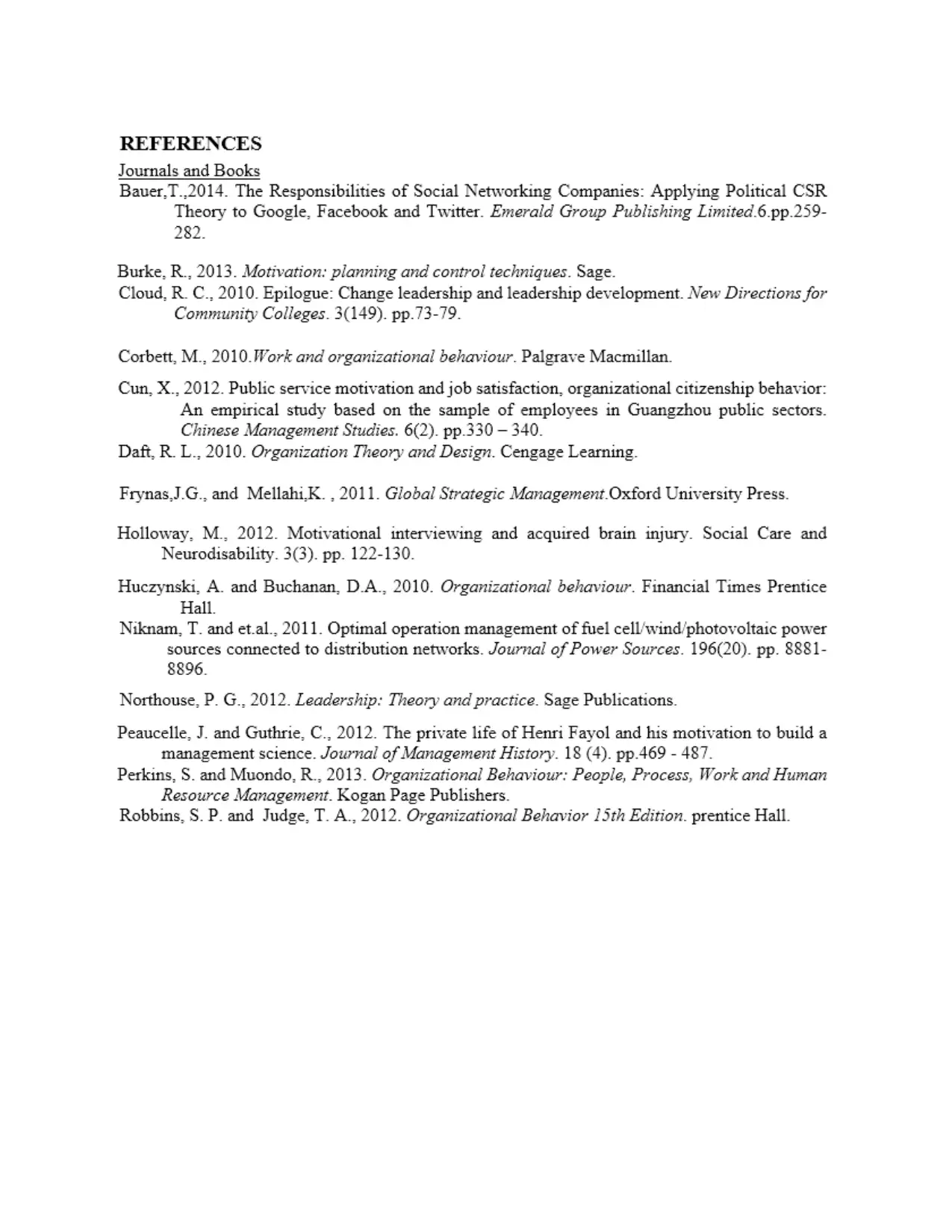
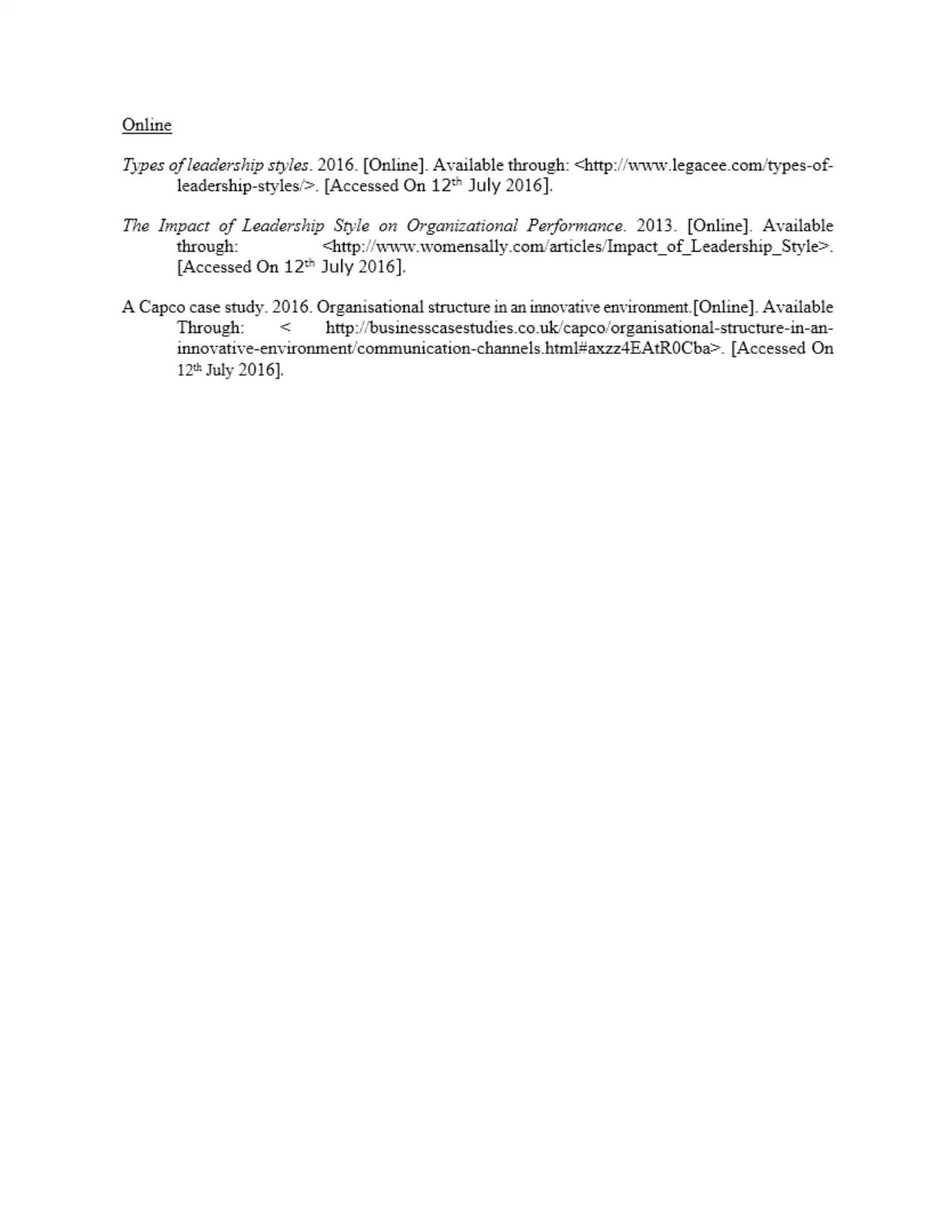
1 out of 16
Related Documents
Your All-in-One AI-Powered Toolkit for Academic Success.
+13062052269
info@desklib.com
Available 24*7 on WhatsApp / Email
![[object Object]](/_next/static/media/star-bottom.7253800d.svg)
Unlock your academic potential
© 2024 | Zucol Services PVT LTD | All rights reserved.





